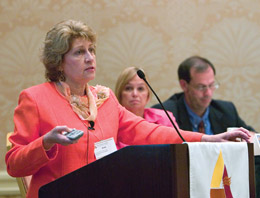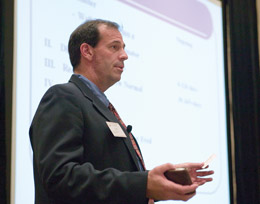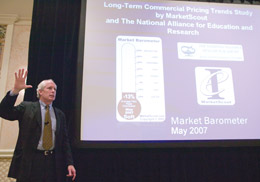Front line reports provide lessons from disasters
By Elisabeth Boone, CPCU
From the ravages of Hurricane Katrina to the horror of school shootings, planning for and responding to disaster was the dominant theme of the Academy Forum conducted by The National Alliance for Insurance Education & Research at its June MEGA educational event in Orlando.
The James K. Ruble MEGA seminar, which is held at different locations around the country each year, is a jam-packed week of classes and forums where attendees have the opportunity both to acquire practical knowledge and to gain insights into key trends and developments in the property/casualty business.
The June meeting covered topics such as crime, wrap-ups, business income, environmental impairment liability, employment practices liability, Internet liability and cyber-media coverage, workers compensation, and a range of life and health insurance and financial planning issues. On the risk management side, offerings included wireless communication, data security, and financial statement analysis. Other sessions focused on agency management issues such as employment and non-piracy agreements, short- and long-term agency perpetuation, retirement planning, and ethics.
At a panel discussion moderated by Christopher Ketcham, executive vice president of the National Alliance Research Academy, two of the four panelists—a risk manager and an agent—provided lessons learned from their first-hand experience dealing with Hurricane Katrina. Another panelist shared her experiences as a school risk manager and described a tragic post-Columbine school shooting incident in Colorado, where she heads up a self-insurance pool for schools. The panel discussion wrapped up with a comprehensive analysis of current property/casualty market conditions and key emerging trends.
Hospital in crisis
Leading off was Jean Shepherd, risk manager for East Jefferson General Hospital, the only hospital in New Orleans that remained open and functioning in the aftermath of Katrina. A New Orleans native with some 20 years’ experience in hospital risk management, Shepherd gave a riveting account of the daunting challenges faced by her staff: loss of electrical power; critically ill patients; dwindling supplies of drugs, food, and other vital supplies; and a host of crime- and law enforcement-related issues.
Although she and her team had developed a detailed emergency management plan for the hospital, Shepherd reminded attendees that there’s no way to know when disaster will strike, what damage it will wreak, or how other human beings will behave in the throes of a catastrophe.
Focusing on what she and her team learned from their Katrina experience, Shepherd observed, “The universal lessons learned during Katrina are applicable to all businesses, public entities, and essential services such as insurance agencies for continued operations and post-disaster planning. The key is to identify hazards for your area and be ready and prepared for the worst.
“Three-day plans are useless,” Shepherd declared. “You need a seven- to 10-day survival plan. ‘There to here’ thinking is critical. Create the doomsday plan.”
An effective disaster plan, Shepherd said, encompasses four key stages: prepare, respond, mitigate, and recover.
The preparation phase begins with a hazard vulnerability analysis or risk assessment of regional threats. “Partner with other like entities outside of your immediate threat area for support if needed,” Shepherd advised. “Prepare your buildings with additional manpower and repair supplies. Prepare your staff: educate, supply lists, communicate expected requirements, and establish emergency contact numbers. Educate key individuals to maintain documentation during the disaster.”
It is essential, Shepherd said, to “have a written plan and communicate it to your employees.” Equally important, she noted, “Encourage employees to have a family plan.”
To prepare for the response phase, Shepherd said, “Identify key individuals to coordinate emergency operations. Conduct drills and discuss regularly.” Finally, “Establish relationships within your community.”
In the mitigation phase, Shepherd said, key elements are business interruption insurance and disaster recovery services to continue immediate post-disaster operations. “Be ready to ‘think outside the box’ for housing needs, business support, community interaction, and employee support such as employee assistance programs, flexible hours, and housing.”
In preparing for the recovery phase, Shepherd said, “Identify key strategies to resume your competitive position in the community. These may need to change depending on the severity of the disaster.” Next, “Collect checklists, data, and monies used during the disaster for insurance verification.” Last but by no means least, she advised, “Allow time for the community to heal.”
Although disaster planning is essential for any private or public facility, Shepherd cautioned attendees, they can’t possibly cover all contingencies. “There is no way to imagine the ‘worst-case scenario,’” she asserted. “Emergency preparedness plans are just that: plans. ‘The cavalry ain’t coming,’” she said with a chuckle.
In both planning for and managing a disaster, Shepherd emphasized, “There is no substitute for leadership. The team must have respect for and trust in leadership, and they must follow. There is no time for committee meetings, debates, and/or second guessing.” Quoting a familiar maxim, she said, “Lead, follow, or get out of the way.”
Despite the fear, loss, and heartbreak caused by Katrina’s devastation, Shepherd declared, “We will be stronger and better for this experience.”
Katrina: an agency responds
Surviving Katrina, coping with its horrifying aftermath, and keeping both employees and clients safe was the Herculean task that faced independent agencies throughout the Gulf Coast area, including the hard-hit Mississippi communities of Biloxi, Gulfport, and Pass Christian.
Before Hurricane Katrina struck, Stewart Sneed Hewes of Gulfport, Mississippi, a unit of Bancorp South Insurance, had the foresight to prepare a comprehensive disaster plan. Scott Naugle, CIC, chief administrative officer of Bancorp South Insurance, told what it was like when the storm slammed into the Gulf Coast on August 29, 2005, followed by a storm surge estimated to have been in excess of 35 feet high at Pass Christian. Amid the ensuing chaos, he said, agency employees helped each other and clients by following the procedures outlined in the disaster plan.
Developing a disaster plan, Naugle said, is an exercise that should involve everyone in the agency. “Gather your staff. Discuss possible scenarios, determine priorities, and assign responsibilities,” he said. “Business continuation and recovery is our business,” Naugle observed. “Developing a business continuation and recovery plan is an ongoing process.”
Ask yourself, Naugle challenged the audience: “How would it look if you were knocked out of business?”
Naugle identified five phases of a disaster:
1. Pre-disaster (ongoing)
2. Disaster strikes/chaos (0 to 120 days)
3. Realization of a new normal (30 to 365+ days)
4. Recovery (“Easily 10 years,” Naugle noted.)
5. Recovered
In developing a disaster plan, he noted, the agency must consider several critical constituencies: employees, clients, carriers, adjusters, the media, attorneys, and regulators.
Of the agency’s constituencies, Naugle asserted, “Employees are the fulcrum.” In addition to dealing with aggressive clients and reluctant carriers, he said, employees face the devastation of their own homes and lives, and must deal with a multitude of family, school, and work issues. “If you’re in the insurance business,” he observed, “you really are a first responder.”
At Stewart Sneed Hewes, each employee was given a wallet card with an out-of-area toll-free number to call and leave voice mail messages after a disaster. Post-Katrina, this allowed for quick, efficient communication among agency staffers to determine their locations, availability, and needs for support and supplies.
With respect to clients, Naugle said, the best medicine is preventive. “Make sure that building limits are the same as flood, wind, and earthquake limits.” Document a client’s decision to refuse coverage by having him or her sign a rejection letter, he advised.
Claims service, Naugle declared, is an agency’s paramount responsibility in the wake of a disaster. “This is what we are paid for,” he said. “Everyone in the agency should be trained to take claims.” If possible, he suggested, use your agency’s Web site to take claims.
Naugle wrapped up his presentation with a Top 10 list for disaster planning:
1. Select your clients.
2. Deal with problem employees NOW.
3. Distribute wallet cards (as described above).
4. Ask carriers for their disaster plans.
5. Make a financial contingency plan. Set aside six months’ worth of money in case your clients can’t pay you.
6. Employees need their own personal disaster recovery plans.
7. If you can, give adjusters office space and housing.
8. Put a block of hotel rooms out of the area on long-term lease.
9. (a) Make it easier to report claims (b) Everyone in the agency should know how to take claims.
10. Review, communicate, and discuss your recovery plan at least quarterly.
School shootings
Troubled young people, easy access to weapons, and educational institutions that simply aren’t prepared for murderous rampages—these can be deadly ingredients for disaster, as we have learned from the horrific incidents at Columbine High School in 1999 and Virginia Tech University earlier this year. School administrators face the daunting challenge of trying to anticipate and prepare for the worst without turning their institutions into fortresses and their students into hypervigilant paranoiacs.
Cheryle Mangels, executive director of the Colorado School Districts Self-Insurance Pool, said, with respect to school shootings, one of the biggest challenges she and the pool face is the “It can’t happen to us” syndrome. In quiet rural districts where everyone knows everyone else, as well as affluent suburban communities where motivated students prepare for elite colleges, no one wants to believe a massacre could happen in their back yard.
Just a year ago, however, the early autumn calm at Platte Canyon High School in Bailey, Colorado, located about 45 minutes west of Denver, was shattered when a gunman invaded the school and took several hostages. He killed one student before turning his weapon on himself, and some female hostages reportedly were sexually assaulted.
The siege ended when SWAT officers used an explosive device to break down a classroom door. That action, Mangels said, was largely responsible for what ended up being an $85,000 property loss.
The Colorado School Districts Self-Insurance Pool has 177 members, representing some 80% of the state’s public schools, and membership is available to schools with grades K through 12.
School shootings fortunately are rare, and Mangels pointed out that the pool also must deal with bread-and-butter coverage issues: fire, arson, vandalism, aging buildings, employment-related concerns, and the tendency of school boards to assume that “everything is covered.”
For example, one school was 30% destroyed by fire because a teacher left a candle lit. At another school, a water line break caused water to rise to a level of 10 feet in an elevator shaft. “The water had to be taken out by hand,” Mangels remarked wryly.
A key concern for the pool, Mangels added, is sexual and physical abuse, especially bullying. “Most school shooters were bullied,” she commented.
Markets for school risks are limited, Mangels said. “Markets get skittish because of crises like school shootings and terrorism alerts in the U.S.”
Eye on the market
Soft and getting softer: That’s the view of veteran property/casualty market watcher Richard Kerr, chairman and chief executive officer of Insurance Data Systems and MarketScout. MarketScout is an e-insurance exchange that develops product distribution portals and other e-commerce business models. MarketScout.com is a site that retail agents and brokers can use to obtain quotes from A rated insurers and specialty underwriters, and to research specific lines of business and market segments.
As an electronic insurance exchange that is used by some 60,000 retail agents, Kerr explained, “MarketScout amalgamates a tremendous amount of data from agents all over the country. We take that data and apply mathematical formulas to determine where the market is on a composite basis throughout the United States.”
This is MarketScout’s Market Barometer, a composite of all property and casualty coverages throughout the country.
As of June, Kerr said, the Market Barometer was down 13%, indicating a continuing softening of the market.
“Insurance companies are making money, and lots of it,” Kerr said. “Insurer profitability is what’s driving the soft market. As a matter of fact, there’s been so much capital accumulated that in order to make an impact on the market this year, we’d have to have in excess of a $100 billion catastrophe. If we go through this year and it’s like another 2006, it will take more than that.”
Kerr identified another new trend. “Traditionally we would see that the larger the account size, the softer the market. But that’s somewhat changed now, because over the last several years the larger accounts have taken such high retentions. As we look at the industry as a whole, we see a lot of opportunistic capacity.
“Post-Katrina, Rita, and Wilma, we were thinking the market was getting ready to turn,” Kerr commented. “Some insurance company CEOs anticipated that not only would the property market turn but also the liability, because there would be such a serious loss of capacity that every line would turn. If I were running an insurance company, that’s what I would say, because my job is to drive shareholder value.”
However, Kerr noted, “That didn’t happen. You’re not going to have big property losses along the coast and have that drive the D&O market. They’re mutually exclusive issues. The market’s too smart, and people are too smart.”
He alluded again to the massive amount of opportunistic capacity available to insurers. “From Bermuda, for example, post-Katrina, Rita and Wilma, there was over $30 billion raised, just like that, waiting for insurers to buy because they didn’t have anywhere else to go. To have the ability, through capitalists and other mechanisms, to raise that kind of capacity that quickly means that this may not be the soft market—it may be the market,” Kerr declared.
On the distribution side, Kerr sees significant opportunities for independent agents.
“Carriers are starting to look at the independent agents, the folks in small-town America,” he commented. “Over 80% of the premium in the United States is generated by agents who are in small-town America whose clients are small businesses. This business is placed not by Aon and Marsh but by you,” Kerr asserted, pointing to the audience.
“So the big insurance companies are looking at you and saying, ‘We want some of that business. Let’s go get it.’ That’s why you see the proliferation of the businessowners policy. All the big carriers are more interested in this market because common sense tells them that business is more profitable in rural America,” Kerr said.
Looking at the market overall, Kerr said, the bottom line is that, absent a major catastrophe, the property market will remain soft, and the tail on liability losses may have less impact than anticipated. “If the losses don’t come,” he asserted, “this soft market is going to be around for a very long time.” * |
|
Click on image for enlargement |
 |
| |
Christopher Ketcham, Executive Vice President of The National Alliance Research Academy, moderates a panel discussion during The James K. Ruble Mega seminar. Panelists are shown below.
|
| |
 |
| |
Jean Shepherd
Risk Manager
East Jefferson General Hospital
New Orleans, Louisiana |
|
| |
 |
| |
Scott Naugle
Chief Administrative Officer
Bancorp South Insurance |
| |
 |
| |
Cheryle Mangels
Executive Director
Colorado School Districts Self-Insurance Pool |
| |
 |
| |
Richard Kerr
Chairman & CEO
Insurance Data Systems & MarketScout |
| |
 |
| |
Dr. William T. Hold (right), president of The National Alliance, speaks with a conference attendee during a break. |
|


